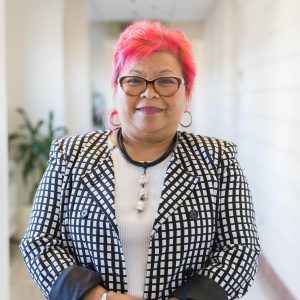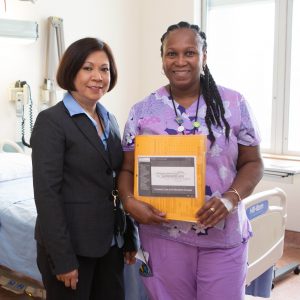#yesthisisnursing
Nurses have the unique privilege to be present in many of life’s most significant moments. They are there to welcome a new life, hold a patient’s hand as they take their last breath, connect with compassion as patients and residents struggle with illness or families face big changes – and to deliver highly complex nursing care.
Nurses are the largest health provider group in Canada and our more than 3,300 nurses play a vital role in the care we provide. This Nursing Week, we wanted to highlight how nurses across our network are making a difference for our patients and residents and community, but also for their colleagues and teams. Meet Erika, Erlinda, Shirley and Cecilia.
Erika

The stroke and neuro unit at Providence sees a diverse group of patients in various stages of recovery. Spending anywhere from two to six weeks on the unit, the patients are there long enough to bond with their care team as they get well enough to go home. Erika Solomon, a registered practical nurse, said that’s her favourite thing about working on the unit.
“Patients come in and often have a long way to go in their recovery,” she said, “which makes it even better when we see them start walking and then eventually go home. Seeing them progress is amazingly rewarding.”
Erika has been working on the unit for less than a year but said she already feels like the team is family, supporting one another in order to be able to provide the best care to patients and their families. She’s getting ready to go back to school to get her nursing degree and said what’s holding her back is the fact that she loves her job so much.
“It’s an incredible feeling helping people as a nurse,” she said. “On our unit especially, people come back to visit and seeing them happy and grateful for what we were able to help with them is so fulfilling – I’m very glad to be where I am.”

For almost 40 years, Erlinda Gallardo has called the 3M general/ orthopaedic surgery unit at St. Joseph’s her home away from home. When people ask her what she’ll do when she retires, she laughs and says she’ll come back and volunteer.
“I love this place – I think I’m part of the walls,” she said.
As a team leader, Erlinda provides support to everyone on the unit – not only patients, who she sits with when needed, and families who she provides comfort to when they’re struggling with processing the diagnosis of their loved one, but also staff who she considers to be family. Her team says that some of her greatest qualities are her ability to inspire people to be efficient and effective in making sure patients receive the highest quality care, and her passion for taking care of the unit – something she says she’s always had.
“My desire is to improve the lives of the patients who depend on our care,” she said. “If you don’t have passion for your work, you won’t last for very long because nursing is not an easy job – it takes courage, care and affection for your work. If I had to go back again I’d still choose nursing because I’m proud of the work we do – when patients receive the care they need, you know you’ve done your part.”

When patients with neurological vulnerability such as dementia or delirium aren’t able to effectively communicate their needs, they may display responsive behaviours which previously may have prompted St. Michael’s staff to put them under constant care – meaning an additional caregiver would be assigned to monitor them to ensure they weren’t harming themselves or others. An initiative led by the dynamic team of Cecilia Santiago, nursing practice manager and Shirley Bell, clinical nurse educator is helping guide teams on effective use of constant care and enhancing patient care.
Shirley and Cecilia, with the Constant Care Working Group at St. Michael’s, adapted guidelines created by the Toronto Academic Health Sciences Network (which Cecilia led the development of) to create decision-making and documentation tools which provide direction for frontline teams to determine when to implement and discontinue constant care.
“The unique part about this is that it’s collaborative – the health-care teams, patients and families are part of the assessment and deciding what’s best for the patient,” said Shirley.
One of the most significant parts of the initiative is encouraging teams to get to know details about the patient that provide insight into their behavior. Shirley said one care team had difficulty with a man who consistently tried to leave the hospital every day at 9 a.m. When his friend came in to visit one day, he told the team that the patient had previously been a stockbroker and was used to buying newspapers every morning. As a result, staff members now bring newspapers in for him to read – he sits in bed and reads the business section and is no longer under constant care.
“Patients have lives before they come to the hospital,” said Cecilia. “Our strategy is patient-centred and involves looking at what worked at home for patients that we can adapt for the hospital – what keeps them calm at home, what’s their sleeping routine like? It’s keeping patients safe and giving them a better experience at the same time.”
About St. Michael’s Hospital
St. Michael’s Hospital provides compassionate care to all who enter its doors. The hospital also provides outstanding medical education to future health care professionals in more than 29 academic disciplines. Critical care and trauma, heart disease, neurosurgery, diabetes, cancer care, care of the homeless and global health are among the Hospital’s recognized areas of expertise. Through the Keenan Research Centre and the Li Ka Shing International Healthcare Education Centre, which make up the Li Ka Shing Knowledge Institute, research and education at St. Michael’s Hospital are recognized and make an impact around the world. Founded in 1892, the hospital is fully affiliated with the University of Toronto.
